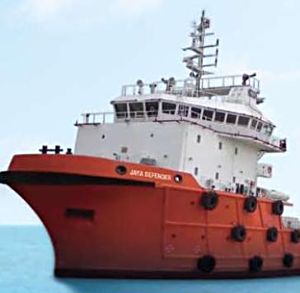This article was recently published on www.nracapital.com and is reproduced with permission

I ATTENDED the Jaya Holdings analysts' briefing for its FY2012 results yesterday. It was well attended. Investors should read both the FY2012 results announcement as well as the 2012 results presentation slides.
On the surface the numbers were unexciting with revenue down 17% to US$82.2mn and net profit down 33% to US$43.8mn.
But a closer look at the numbers and the commentary during the presentation reveals that Jaya has crossed an operational turning point and could be entering a period of sustained earnings growth.
Let’s look at some of the numbers:
a) look at page 17 of the presentation slides – it shows that between 2012 and 2011, EBITDA fell 37.8%. But if we exclude gain on vessel sales and gains on other disposals, the decline in EBITDA was significantly lower at less than 15%
b) the second and more important trend is the growth in offshore shipping EBITDA which grew 46.4% to US$41mn.
The Q4 numbers show an even stronger recovery in chartering or offshore-shipping income with Q4 revenue for offshore higher by 69.7% and EBITDA for the same period up by 131.8%. Several factors contributing to this trend are more vessels at 28 against 23 previously, higher utilisation rate at 82% compared to less than 70% for the first three quarters and finally firmer charter rates.
FY2013 should see Jaya back in the black and ontrack for a sustained recovery in earnings !!
The trend of firmer charter rates and higher utilisation in Q4-2012 is set to continue with Jaya expecting charter rates to rise 5-10% on renewals in the current FY for about one third of its fleet. Firmer rates and growing interest in time charter as opposed to shorter term spot charters seems to be signalling better times ahead. Jaya will also enjoy better charter margins for its new fleet.
This trend fits in nicely with Jaya’s new strategy of increasing its charter income which is more predictable and relying less on vessel sales. Its plan to build another 12 vessels in 2013 and 2014 is ontrack and will cost the Group about US$265mn which it intends to finance from internal sources and cashflow. After all, Jaya’s net debt is less than 10% as at the end of June 2012.
The company will continue to sell vessels with two of the six being built in 2013 already sold.

The financial rescue package – a Blessing as well as an Albatross
When Jaya got into trouble in 2009, it entered into a very attractive five year debt restructuring plan which involved only interest payments for the first two years and principal and interest payments from years three to five. It has already started principal repayments two quarters ago.
The “Blessing” here was its cost of funds at 2.75% above inter-bank rates which means US$ funding for five years at less than 4%. In today’s context this is very attractive and while Jaya’s strong balance sheet allows it to refinance this package, economic sense doesn’t justify doing it as the cost of funds especially in US$ today is now much higher than what it is currently paying.
The “Albatross” for shareholders is that there will be no dividends for shareholders over the five year period. So no dividends for another three years – shareholders must take this in bigger capital gains if they are prepared to wait especially now when the core chartering businesses is improving.
Shareholders and new management
The fragmented shareholding structure now is a perceived problem as it could create an overhang in the short term until or unless one of two shareholders consolidate their holdings which might trigger a GO (if and when it materialises).
The new management at Jaya seems to be taking a more strategic medium term view on the business with a view of growing the charter and recurrent income portion. The turn in the sector fundamentals should assist them in the execution of this repositioning as rising charter income and cashflows will give management more leeway in making more strategic investment decisions about vessel disposals instead of being forced to undertake vessel sales for cashflow.
Financial Position remains sound
Jaya’s balance sheet is sound with net gear at less than 10% and with strong operational cashflows, the group can comfortably finance its fleet expansion plan of 12 vessels over the next two years without going to shareholders for funds. The Group also has sufficient cash on its balance sheet to retire its debt fully but as it cannot raise new debt financing at more competitive borrowing rates – it doesn’t make sense to do so.
Jaya – still one of my Stock Picks but we can now see the light at end of the tunnel….think its time to start accumulating for capital gain
Since 2009, Jaya has been undervalued relative to its NAV – and with charter income flat, the global economy slowing sharply and no dividends – shareholders could not see how the value would be unlocked.
Things are different now. The operating environment for OSVs is much better than for shipping as long as crude oil prices stay above US$80 per barrel, Jaya will see sustained improvement in charter income from a bigger fleet and higher charter rates.
We will also see earnings boosted by vessel sales. Bearing in mind that no dividends will be paid for the next three years until the debt restructuring package has ended, investors can still invest for capital gains. I think it's time to start accumulating on a two to three year view for decent capital gains. For more on my price target, look at my Stock Picks section.
Recent story: 9 stocks riding high: FRASERS, INTRACO, SARIN, JAYA, SELECT, VIZ BRANZ, etc








Comments
Thanks for the write up. Good points being raised. Among the factors contributing to the optimistic outlook for this counter is its production tie-up with the Dutch specialist shipbuilding group IHC Merwede. Certainly vested investors can look forward to this collaborative venture as an extra source of income generator in the ensuing years.
One thing though, Jaya management should embark on a more investor friendly mode incorporating more transparency with more disclosures, as well as holding regular briefings to investors and fund managers.